In Silico Evaluation of Bioactive Compounds of Artemisia pallens Targeting the Efflux Protein of Multidrug-Resistant Acinetobacter baumannii (LAC-4 Strain)
Abstract
:1. Introduction
2. Result and Discussion
2.1. ADMET Analysis
2.2. Homology Modelling and Validation of Predicted 3D Structure of A. baumanni Efflux Protein
2.3. Validation of Docking Process
2.4. Molecular Docking
2.5. Molecular Dynamics
3. Materials and Methods
3.1. Preparation of Solvent Extract
3.2. Identification of Bioactive Compounds from Aerial Parts of A. pallens
3.3. Hardware and Software
3.4. Ligand-Based Pharmacokinetics Analysis
3.5. Homology Modelling and Protein Structure Prediction
3.6. Preparation of Protein and Ligand Molecules
3.7. Active Site Prediction
3.8. Molecular Docking
3.9. Molecular Dynamics (MD) Simulations Analysis
4. Conclusions
Supplementary Materials
Author Contributions
Funding
Institutional Review Board Statement
Informed Consent Statement
Data Availability Statement
Conflicts of Interest
References
- Shu, H.; Li, L.; Wang, Y.; Guo, Y.; Wang, C.; Yang, C.; Gu, L.; Cao, B. Prediction of the Risk of Hospital Deaths in Patients with Hospital-Acquired Pneumonia Caused by Multidrug-Resistant Acinetobacter baumannii Infection: A Multi-Center Study. Infect. Drug Resist. 2020, 13, 4147–4154. [Google Scholar] [CrossRef] [PubMed]
- Mirzaei, B.; Bazgir, Z.N.; Goli, H.R.; Iranpour, F.; Mohammadi, F.; Babaei, R. Prevalence of multi-drug resistant (MDR) and extensively drug-resistant (XDR) phenotypes of Pseudomonas aeruginosa and Acinetobacter baumannii isolated in clinical samples from Northeast of Iran. BMC Res. Notes 2020, 13, 380. [Google Scholar] [CrossRef] [PubMed]
- Jovcic, B.; Novovic, K.; Dekic, S.; Hrenovic, J. Colistin Resistance in Environmental Isolates of Acinetobacter baumannii. Microb. Drug Resist. 2021, 27, 328–336. [Google Scholar] [CrossRef] [PubMed]
- Doughari, H.J.; Ndakidemi, P.A.; Human, I.S.; Benade, S. The ecology, biology and pathogenesis of Acinetobacter spp.: An overview. Microbes Environ. 2011, 26, 101–112. [Google Scholar] [CrossRef] [PubMed]
- Yang, C.H.; Su, P.W.; Moi, S.H.; Chuang, L.Y. Biofilm Formation in Acinetobacter baumannii: Genotype-Phenotype Correlation. Molecules 2019, 24, 1849. [Google Scholar] [CrossRef]
- Trottier, V.; Segura, P.G.; Namias, N.; King, D.; Pizano, L.R.; Schulman, C.I. Outcomes of Acinetobacter baumannii infection in critically ill burned patients. J. Burn Care Res. 2007, 28, 248–254. [Google Scholar] [CrossRef]
- Gaynes, R.; Edwards, J.R. National Nosocomial Infections Surveillance System. Overview of nosocomial infections caused by gram-negative bacilli. Clin. Infect. Dis. 2005, 41, 848–854. [Google Scholar]
- Geisinger, E.; Isberg, R.R. Interplay between Antibiotic Resistance and Virulence during Disease Promoted by Multidrug-Resistant Bacteria. J. Infect. Dis. 2017, 215, S9–S17. [Google Scholar] [CrossRef]
- Tipton, K.A.; Farokhyfar, M.; Rather, P.N. Multiple roles for a novel RND-type efflux system in Acinetobacter baumannii AB5075. Microbiologyopen 2017, 6, e00418. [Google Scholar] [CrossRef]
- Sheldon, J.R.; Skaar, E.P. Acinetobacter baumannii can use multiple siderophores for iron acquisition, but only acinetobactin is required for virulence. PLoS Pathog. 2020, 16, e1008995. [Google Scholar] [CrossRef]
- Liu, D.; Liu, Z.S.; Hu, P.; Cai, L.; Fu, B.Q.; Li, Y.S.; Lu, S.Y.; Liu, N.N.; Ma, X.L.; Chi, D.; et al. Characterization of surface antigen protein 1 (SurA1) from Acinetobacter baumannii and its role in virulence and fitness. Vet. Microbiol. 2016, 186, 126–138. [Google Scholar] [CrossRef] [PubMed]
- Selvaraj, A.; Valliammai, A.; Sivasankar, C.; Suba, M.; Sakthivel, G.; Pandian, S.K. Antibiofilm and antivirulence efficacy of myrtenol enhances the antibiotic susceptibility of Acinetobacter baumannii. Sci. Rep. 2020, 10, 21975. [Google Scholar] [CrossRef] [PubMed]
- Balcazar, J.L.; Subirats, J.; Borrego, C.M. The role of biofilms as environmental reservoirs of antibiotic resistance. Front. Microbiol. 2015, 6, 1216. [Google Scholar] [CrossRef] [PubMed]
- Moosavian, M.; Ahmadi, K.; Shoja, S.; Mardaneh, J.; Shahi, F.; Afzali, M. Antimicrobial resistance patterns and their encoding genes among clinical isolates of Acinetobacter baumannii in Ahvaz, Southwest Iran. MethodsX 2020, 7, 101031. [Google Scholar] [CrossRef]
- Kumar, S.; Yadav, M.; Sehrawat, N.; Alrehaili, J.; Anwer, R. Pathobiology of Multidrug Resistant Acinetobacter baumannii: An update. Asian J. Biol. Life Sci. 2021, 10, 15–26. [Google Scholar] [CrossRef]
- Evans, B.A.; Hamouda, A.; Amyes, S.G. The Rise of Carbapenem-Resistant Acinetobacter baumannii. Curr. Pharm. Des. 2013, 19, 223–238. [Google Scholar] [CrossRef] [PubMed]
- Suvaithenamudhan, S.; Parthasarathy, S. Structure based virtual screening for the identification of potential inhibitors for penicillin binding protein 2B of the resistant 5204 strain of streptococcus pneumoniae. Curr. Bioinform. 2016, 11, 66–78. [Google Scholar] [CrossRef]
- Suvaithenamudhan, S.; Parthasarathy, S. Molecular Dynamics Simulations of Novel Potential Inhibitors for Penicillin Binding Protein 2B of the Resistant 5204 Strain of Streptococcus Pneumoniae. Curr. Comput. Aided Drug Des. 2017, 13, 234–248. [Google Scholar] [CrossRef]
- Kumar, S.; Singhal, L.; Ray, P.; Gautam, V. Over-expression of RND and MATE efflux pumps contribute to decreased susceptibility in clinical isolates of carbapenem resistant Acinetobacter baumannii. Int. J. Pharm. Res. 2020, 12, 342–349. [Google Scholar]
- Farnsworth, N.R.; Akerele, O.; Bingel, A.S.; Soejarto, D.D.; Guo, Z. Medicinal Plants in Therapy. Bull. World Health Organ. 1985, 63, 965–981. [Google Scholar] [CrossRef]
- Nathar, V.N.; Yatoo, G.M. Micropropagation of an Antidiabetic Medicinal Plant, Artemisia pallens. Turk. J. Bot. 2014, 38, 491–498. [Google Scholar] [CrossRef]
- Kumar, A.P.; Kumud, U. Pharmacognostic and Phytochemical Investigation of Aerial Parts of Artemisia Pallens Wall Ex.Dc. Pharmacogn. J. 2010, 2, 285–288. [Google Scholar] [CrossRef]
- Pavithra, K.S.; Annadurai, J.; Pavithra, S.; Ragunathan, R. Phytochemical, Antioxidant and a Study of Bioactive Compounds from Artemisia Pallens. J. Pharmacog. Phytochem. 2018, 7, 664–675. [Google Scholar]
- Husain, A.; Virmani, O.P.; Sharma, A.; Kumar, A.; Misra, L.N. Major Essential Oil-Bearing Plants of India; Central Institute of Medicinal and Aromatic Plants: Lucknow, India, 1988; 237p. [Google Scholar]
- Asolkar, L.; Kakkar, K.; Chakra, O. Second Supplement to Glossary of Indian Medicinal Plants with Active Principles; Publications & Information Directorate: Devon, UK, 1992; pp. 92–97. [Google Scholar]
- Nakhare, S.; Garg, S.C. Anthelmintic Activity of the Essential Oil of Artemisia Pallens Wall. Anc. Sci. Life 1991, 10, 185–186. [Google Scholar]
- Devare, S.M.; Patil, J.A.; Gaikwad, S.A.; Torne, R.C.; Deshpande, N.R.; Salvekar, J.P. Antioxidant Potential of Artemisia Pallens Roots. Int. J. PharmTech Res. 2013, 5, 1360–1363. [Google Scholar]
- Verma, P.; Tiwari, M.; Tiwari, V. In Silico High-Throughput Virtual Screening and Molecular Dynamics Simulation Study to Identify Inhibitor for AdeABC Efflux Pump of Acinetobacter baumannii. J. Biomol. Struct. Dyn. 2018, 36, 1182–1194. [Google Scholar] [CrossRef] [PubMed]
- Verma, P.; Maurya, P.; Tiwari, M.; Tiwari, V. In-Silico Interaction Studies Suggest RND Efflux Pump Mediates Polymyxin Resistance in Acinetobacter baumannii. J. Biomol. Struct. Dyn. 2019, 37, 95–103. [Google Scholar] [CrossRef] [PubMed]
- Hanganu, D.; Niculae, M.; Ielciu, I.; Olah, N.K.; Munteanu, M.; Burtescu, R.; Ștefan, R.; Olar, L.; Pall, E.; Andrei, S.; et al. Chemical Profile, Cytotoxic Activity and Oxidative Stress Reduction of Different Syringa vulgaris L. Extracts. Molecules 2021, 26, 3104. [Google Scholar] [CrossRef] [PubMed]
- Saeedan, A.S.; Soliman, G.A.; Abdel-Rahman, R.F.; Abd-Elsalam, R.M.; Ogaly, H.A.; Alharthy, K.M.; Abdel-Kader, M.S. Possible Synergistic Antidiabetic Effects of Quantified Artemisia Judaica Extract and Glyburide in Streptozotocin-Induced Diabetic Rats via Restoration of Ppar-α mRNA Expression. Biology 2021, 10, 796. [Google Scholar] [CrossRef] [PubMed]
- Sangpairoj, K.; Settacomkul, R.; Siangcham, T.; Meemon, K.; Niamnont, N.; Sornkaew, N.; Tamtin, M.; Sobhon, P.; Vivithanaporn, P. Hexadecanoic Acid-Enriched Extract of Halymenia Durvillei Induces Apoptotic and Autophagic Death of Human Triple-Negative Breast Cancer Cells by Upregulating ER Stress. Asian Pac. J. Trop. Biomed. 2022, 12, 132–140. [Google Scholar]
- Rajendrasozhan, S.; Moll, H.E.; Snoussi, M.; Romeilah, R.M.; Shalaby, E.A.; Younes, K.M.; El-Beltagi, H.S. Phytochemical Screening and Antimicrobial Activity of Various Extracts of Aerial Parts of Rhanterium epapposum. Processes 2021, 9, 1351. [Google Scholar] [CrossRef]
- Doughari, J.H.; Saa-Aondo, M. Phytochemical analysis of crude methanol extracts and antimicrobial activity of n-hexane fractions of methanol seed and pod extracts of Prosopis Africana on some selected microrganisms. Archives 2021, 2, 121–137. [Google Scholar]
- Ananth, S.; Thangamathi, P. Larvicidal Efficacy of Fabricated Silver Nanoparticles from Butea Monosperma Flower Extract against Dengue Vector, Aedes Aegypti. Biotech Today Int. J. Biol. Sci. 2018, 8, 20–29. [Google Scholar] [CrossRef]
- Abbasipour, H.; Mahmoudvand, M.; Rastegar, F.; Hosseinpour, M.H. Fumigant Toxicity and Oviposition Deterrency of the Essential Oil from Cardamom, Elettaria Cardamomum, against Three Stored—Product Insects. J. Insect Sci. 2011, 11, 165. [Google Scholar] [CrossRef] [PubMed]
- Schrödinger Release 2022-1: Maestro; Schrödinger LLC: New York, NY, USA, 2021.
- Schrödinger Release 2022-1: QikProp; Schrödinger LLC: New York, NY, USA, 2021.
- Shcherbakov, A.A.; Hisao, G.; Mandala, V.S.; Thomas, N.E.; Soltani, M.; Salter, E.A.; Davis, J.H., Jr.; Henzler-Wildman, K.A.; Hong, M. Structure and dynamics of the drug-bound bacterial transporter EmrE in lipid bilayers. Nat. Commun. 2021, 12, 172. [Google Scholar] [CrossRef] [PubMed]
- Pruitt, K.D.; Tatusova, T.; Maglott, D.R. NCBI Reference Sequences (RefSeq): A Curated Non-Redundant Sequence Database of Genomes, Transcripts and Proteins. Nucleic Acids Res. 2007, 35, D61–D65. [Google Scholar] [CrossRef] [PubMed]
- Greenwood, J.R.; Calkins, D.; Sullivan, A.P.; Shelley, J.C. Towards the Comprehensive, Rapid, and Accurate Prediction of the Favorable Tautomeric States of Drug-like Molecules in Aqueous Solution. J. Comput. Aided Mol. 2010, 24, 591–604. [Google Scholar] [CrossRef] [PubMed]
- Shelley, J.C.; Cholleti, A.; Frye, L.L.; Greenwood, J.R.; Timlin, M.R.; Uchimaya, M. Epik: A Software Program for PKa Prediction and Protonation State Generation for Drug-like Molecules. J. Comput.-Aided Mol. Des. 2007, 21, 681–691. [Google Scholar] [CrossRef]
- Roos, K.; Wu, C.; Damm, W.; Reboul, M.; Stevenson, J.M.; Lu, C.; Dahlgren, M.K.; Mondal, S.; Chen, W.; Wang, L.; et al. OPLS3e: Extending Force Field Coverage for Drug-Like Small Molecules. J. Chem. Theory Comput. 2019, 15, 1863–1874. [Google Scholar] [CrossRef]
- Harder, E.; Damm, W.; Maple, J.; Wu, C.; Reboul, M.; Xiang, J.Y.; Wang, L.; Lupyan, D.; Dahlgren, M.K.; Knight, J.L.; et al. OPLS3: A Force Field Providing Broad Coverage of Drug-like Small Molecules and Proteins. J. Chem. Theory Comput. 2016, 12, 281–296. [Google Scholar] [CrossRef]
- Linstrom, P.J.; Mallard, W.G. The NIST Chemistry WebBook: A Chemical Data Resource on the Internet. J. Chem. Eng. Data 2001, 46, 1059–1063. [Google Scholar] [CrossRef]
- Schrödinger Release 2022-1: LigPrep; Schrödinger LLC: New York, NY, USA, 2021.
- Schrödinger Release 2022-1: Epik Module; Schrödinger LLC: New York, NY, USA, 2021.
- Lu, C.; Wu, C.; Ghoreishi, D.; Chen, W.; Wang, L.; Damm, W.; Ross, G.A.; Dahlgren, M.K.; Russell, E.; Von Bargen, C.D.; et al. OPLS4: Improving Force Field Accuracy on Challenging Regimes of Chemical Space. J. Chem. Theory Comput. 2021, 17, 4291–4300. [Google Scholar] [CrossRef] [PubMed]
- Jorgensen, W.; Tirado-Rives, J. The OPLS [Optimized Potentials for Liquid Simulations] Potential Functions for Proteins, Energy Minimizations for Crystals of Cyclic Peptides and Crambin. J. Am. Chem. Soc. 1988, 110, 1657–1666. [Google Scholar] [CrossRef] [PubMed]
- Halgren, T. Identifying and characterizing binding sites and assessing druggability. J. Chem. Inf. Model. 2009, 49, 377–389. [Google Scholar] [CrossRef]
- Halgren, T. New method for fast and accurate binding-site identification and analysis. Chem. Biol. Drug Des. 2007, 69, 146–148. [Google Scholar] [CrossRef]
- Halgren, T.A.; Murphy, R.B.; Friesner, R.A.; Beard, H.S.; Frye, L.L.; Pollard, W.T.; Banks, J.L. Glide: A New Approach for Rapid, Accurate Docking and Scoring. 2. Enrichment Factors in Database Screening. J. Med. Chem. 2004, 47, 1750–1759. [Google Scholar] [CrossRef]
- Friesner, R.A.; Murphy, R.B.; Repasky, M.P.; Frye, L.L.; Greenwood, J.R.; Halgren, T.A.; Sanschagrin, P.C.; Mainz, D.T. Extra Precision Glide: Docking and Scoring Incorporating a Model of Hydrophobic Enclosure for Protein-Ligand Complexes. J. Med. Chem. 2006, 49, 6177–6196. [Google Scholar] [CrossRef]
- Friesner, R.A.; Banks, J.L.; Murphy, R.B.; Halgren, T.A.; Klicic, J.J.; Mainz, D.T.; Repasky, M.P.; Knoll, E.H.; Shelley, M.; Perry, J.K.; et al. Glide: A New Approach for Rapid, Accurate Docking and Scoring. 1. Method and Assessment of Docking Accuracy. J. Med. Chem. 2004, 47, 1739–1749. [Google Scholar] [CrossRef]
- van Gunsteren, W.F.; Billeter, S.R.; Eising, A.A.; Hünenberger, P.H.; Krüger, P.; Mark, A.E.; Scott, W.R.P.; Tironi, I.G. Biomolecular Simulation: The GROMOS96 Manual and User Guide; Verlag der Fachvereine: Zürich, Switzerland, 1996; pp. 1–1024. [Google Scholar]
- Oostenbrink, C.; Villa, A.; Mark, A.E.; van Gunsteren, W.F. A Biomolecular Force Field Based on the Free Enthalpy of Hydration and Solvation: The GROMOS Force-Field Parameter Sets 53A5 and 53A6. J. Comput. Chem. 2004, 25, 1656–1676. [Google Scholar] [CrossRef]
- Schüttelkopf, A.W.; van Aalten, D.M.F. PRODRG: A Tool for High-Throughput Crystallography of Protein-Ligand Complexes. Acta Crystallogr. Sect. D Biol. Crystallogr. 2004, 60, 1355–1363. [Google Scholar] [CrossRef]
- Hess, B.; Bekker, H.; Berendsen, H.J.C.; Fraaije, J.G.E.M. LINCS: A Linear Constraint Solver for Molecular Simulations. J. Comput. Chem. 1997, 18, 1463–1472. [Google Scholar] [CrossRef]
- Essmann, U.; Perera, L.; Berkowitz, M.L.; Darden, T.; Lee, H.; Pedersen, L.G. A Smooth Particle Mesh Ewald Method. J. Chem. Phys. 1995, 103, 8577–8593. [Google Scholar] [CrossRef]
- Darden, T.; York, D.; Pedersen, L. Particle mesh Ewald: An N-Log (N) method for Ewald sums in large systems. J. Chem. Phys. 1993, 98, 10089–10092. [Google Scholar] [CrossRef]
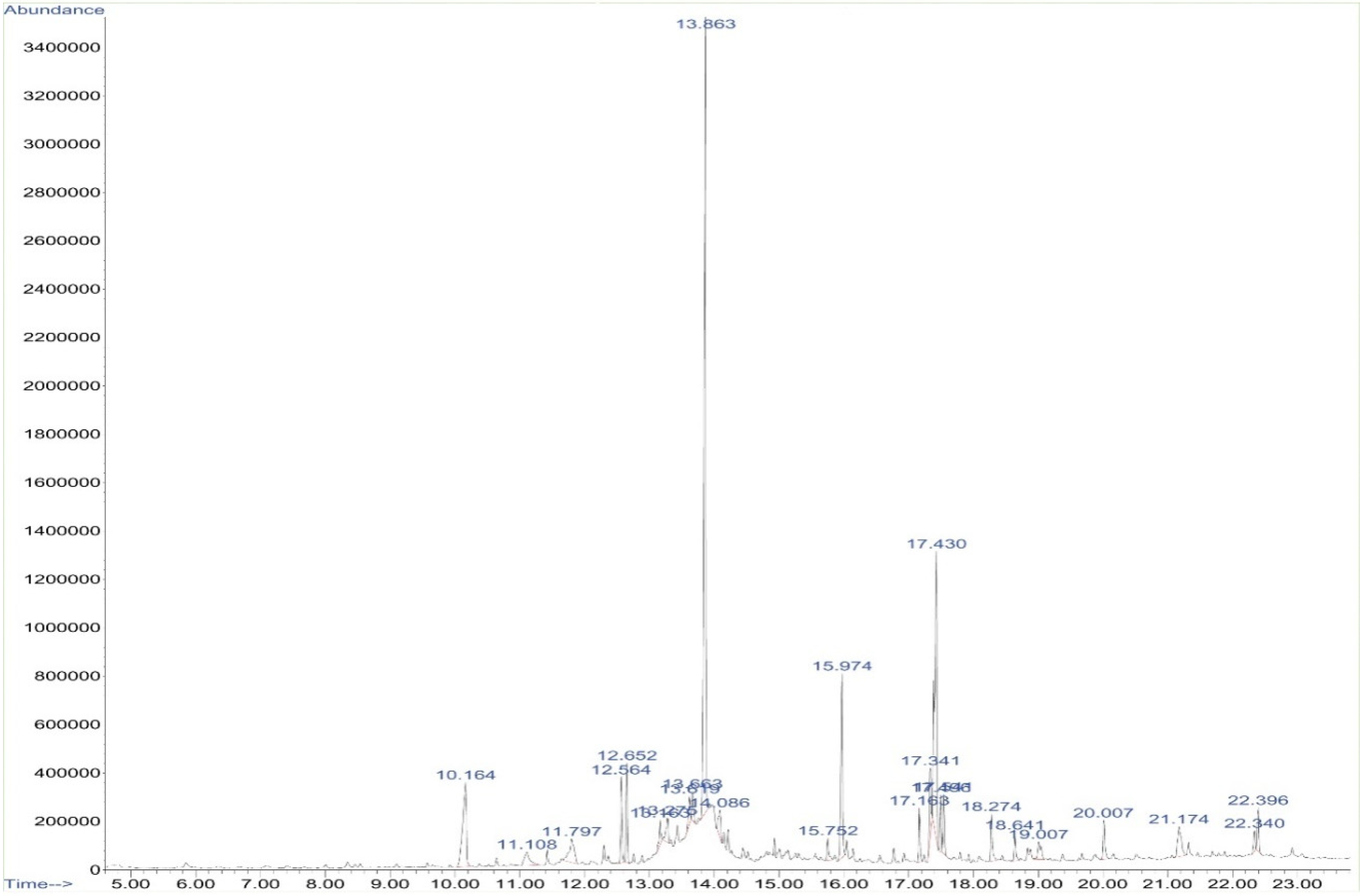
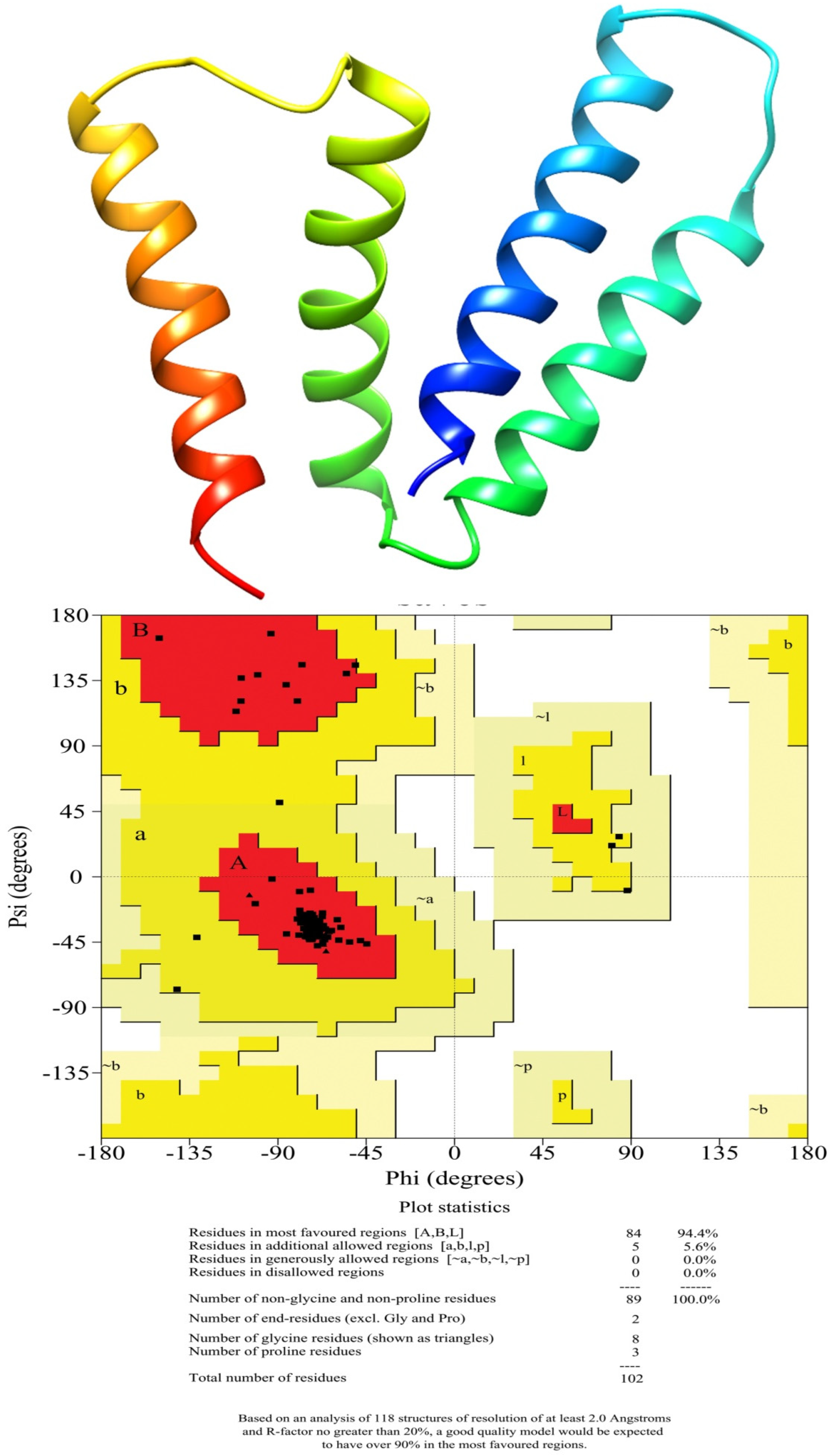
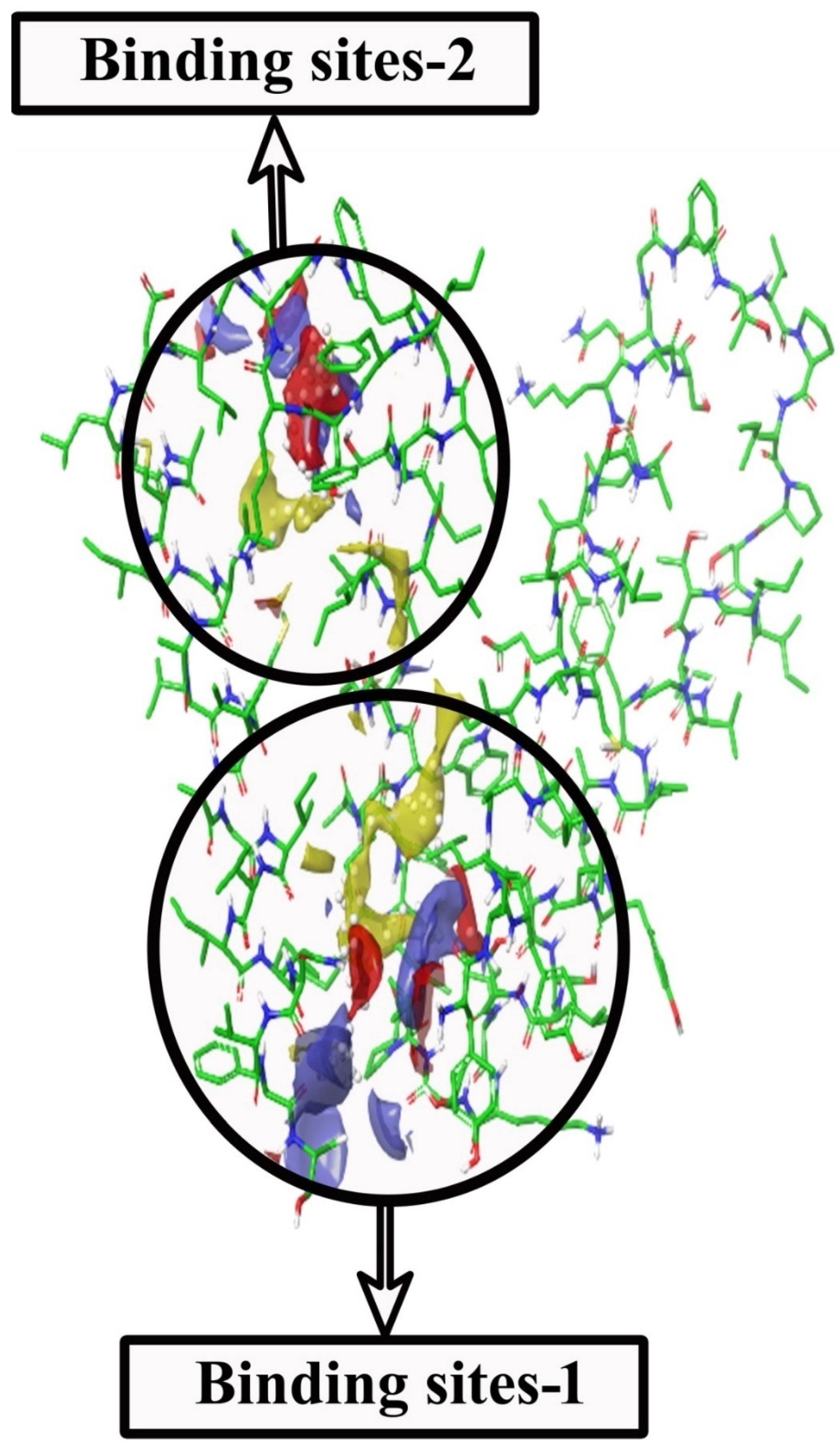
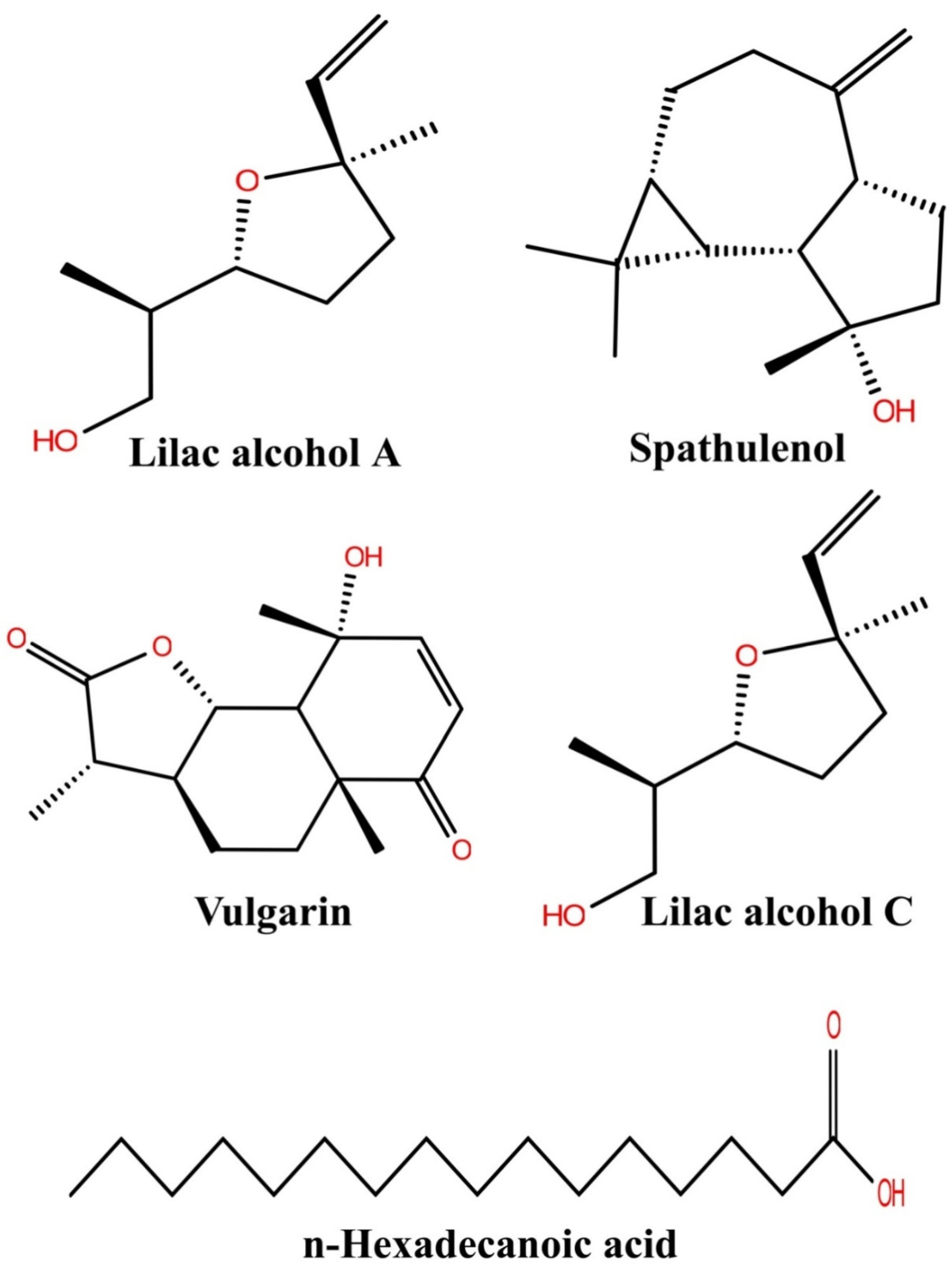

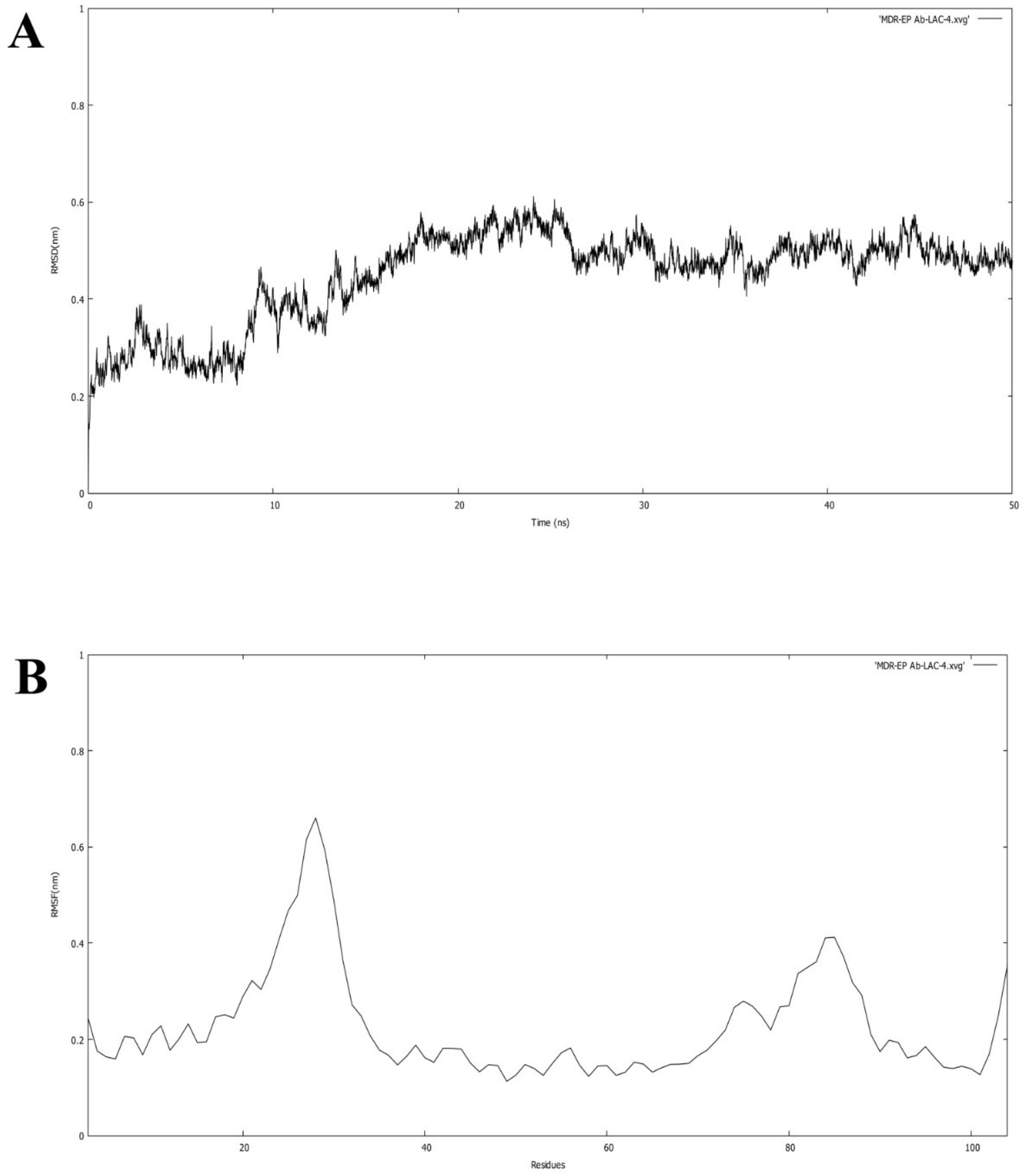
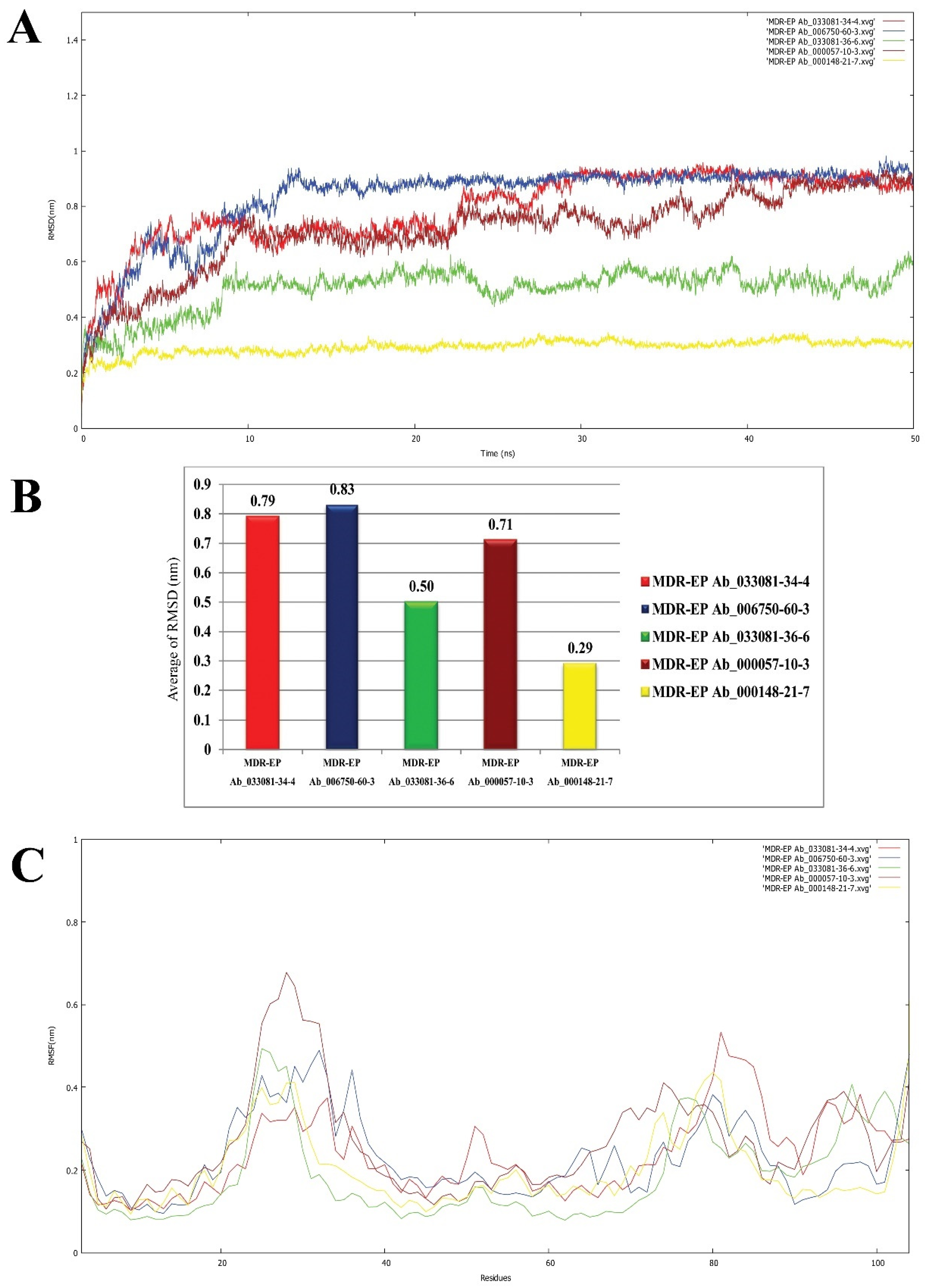
| Sl. No | Retention Time | CAS Registry Number | Name of the Compound | Molecular Formula | Molecular Weight | Peak Area (%) |
|---|---|---|---|---|---|---|
| 1 | RT-10.164 | 033081-34-4 | Lilac alcohol A | C10H18O2 | 170.251 | 7.29 |
| 2 | RT-12.652 | 006750-60-3 | Spathulenol | C15H24O | 220.354 | 3.03 |
| 3 | RT-13.863 | 033081-36-6 | Lilac alcohol C | C10H18O2 | 170.251 | 32.77 |
| 4 | RT-15.974 | 000057-10-3 | n-Hexadecanoic acid | C16H32O2 | 256.428 | 7.92 |
| 5 | RT-17.430 | 000148-21-7 | Vulgarin | C15H20O4 | 264.321 | 15.14 |
| Compound Name | MW | HB Donor | HB Acceptor | SASA | QPlogPo/w | QPlogBB | QPlogS | %Human Oral Absorption |
|---|---|---|---|---|---|---|---|---|
| Lilac alcohol A | 170.251 | 1 | 2.450 | 420.285 | 2.311 | −0.030 | −2.429 | 100 |
| Spathulenol | 220.354 | 1 | 0.750 | 451.722 | 3.937 | 0.355 | −3.986 | 100 |
| Lilac alcohol C | 170.251 | 1 | 2.450 | 420.285 | 2.311 | −0.030 | −2.429 | 100 |
| n-Hexadecanoic acid | 256.428 | 1 | 2.000 | 675.898 | 5.282 | −1.494 | −5.593 | 87.129 |
| Vulgarin | 264.321 | 1 | 5.750 | 479.884 | 1.383 | −0.616 | −2.934 | 83.570 |
| Binding Sites | AA Residues | S Score * | Size | D Score † | Volume |
|---|---|---|---|---|---|
| Binding site_1 | 3,4,6,7,10,49,53,54,57,61, 65,97,100,101,103,104 | 0.844 | 55 | 0.861 | 219.520 |
| Binding site_2 | 68,71,72,75,77,78,79,80,81, 82,90 | 0.742 | 43 | 0.666 | 128.968 |
| Sl.No | Ligands | CAS Registry. NO | Amino Acid | H-Bond Interaction | Bond Length (Å) | Glide Score (kcal/mol) | MM-GBSA ΔGbind (kcal/mol) |
|---|---|---|---|---|---|---|---|
| 1 | Lilac alcohol A | 033081-34-4 | TYR3 LEU6 | H…O O…H | 1.74 2.17 | −3.706 | −24.54 |
| 2 | Spathulenol | 006750-60-3 | TYR3 | H…O | 2.08 | −3.652 | −30.51 |
| 3 | Lilac alcohol C | 033081-36-6 | TYR3 LEU6 | H…O O…H | 1.74 2.17 | −3.706 | −24.54 |
| 4 | n-Hexadecanoic acid | 000057-10-3 | ASN101 | O…H | 1.85 | −2.187 | −33.19 |
| 5 | Vulgarin | 000148-21-7 | TYR3 TYR3 | H…O O…H | 2.05 2.13 | −4.775 | −39.34 |
| Sl.No | Ligands | CAS Registry. NO | Average Hydrogen Bond Interactions |
|---|---|---|---|
| 1 | Lilac alcohol A | 033081-34-4 | 0.02 |
| 2 | Spathulenol | 006750-60-3 | 0.01 |
| 3 | Lilac alcohol C | 033081-36-6 | 0.04 |
| 4 | n-Hexadecanoic acid | 000057-10-3 | 0.15 |
| 5 | Vulgarin | 000148-21-7 | 3.04 |
Publisher’s Note: MDPI stays neutral with regard to jurisdictional claims in published maps and institutional affiliations. |
© 2022 by the authors. Licensee MDPI, Basel, Switzerland. This article is an open access article distributed under the terms and conditions of the Creative Commons Attribution (CC BY) license (https://creativecommons.org/licenses/by/4.0/).
Share and Cite
Suvaithenamudhan, S.; Ananth, S.; Mariappan, V.; Dhayabaran, V.V.; Parthasarathy, S.; Ganesh, P.S.; Shankar, E.M. In Silico Evaluation of Bioactive Compounds of Artemisia pallens Targeting the Efflux Protein of Multidrug-Resistant Acinetobacter baumannii (LAC-4 Strain). Molecules 2022, 27, 5188. https://doi.org/10.3390/molecules27165188
Suvaithenamudhan S, Ananth S, Mariappan V, Dhayabaran VV, Parthasarathy S, Ganesh PS, Shankar EM. In Silico Evaluation of Bioactive Compounds of Artemisia pallens Targeting the Efflux Protein of Multidrug-Resistant Acinetobacter baumannii (LAC-4 Strain). Molecules. 2022; 27(16):5188. https://doi.org/10.3390/molecules27165188
Chicago/Turabian StyleSuvaithenamudhan, Suvaiyarasan, Sivapunniyam Ananth, Vanitha Mariappan, Victor Violet Dhayabaran, Subbiah Parthasarathy, Pitchaipillai Sankar Ganesh, and Esaki Muthu Shankar. 2022. "In Silico Evaluation of Bioactive Compounds of Artemisia pallens Targeting the Efflux Protein of Multidrug-Resistant Acinetobacter baumannii (LAC-4 Strain)" Molecules 27, no. 16: 5188. https://doi.org/10.3390/molecules27165188
APA StyleSuvaithenamudhan, S., Ananth, S., Mariappan, V., Dhayabaran, V. V., Parthasarathy, S., Ganesh, P. S., & Shankar, E. M. (2022). In Silico Evaluation of Bioactive Compounds of Artemisia pallens Targeting the Efflux Protein of Multidrug-Resistant Acinetobacter baumannii (LAC-4 Strain). Molecules, 27(16), 5188. https://doi.org/10.3390/molecules27165188






